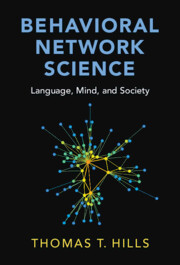Book contents
- Frontmatter
- Contents
- Additional Resources
- Introduction: Structure Matters
- Part I A Brief Guide to Network Science
- Part II Language
- 4 Zipf’s Law of Meaning: The Degree Distribution of the Mind
- 5 Network Learning: Growing a Lexicon by Degrees
- 6 What Is Distinctive: Exploring Edge Types in Multilayer Networks
- 7 The Small-World Spectrum: Using Small Worlds to Compare Networks
- 8 The Birthplace of New Words: Identifying Node Origins
- 9 Agent-Based Models of Language Emergence: Structure Favors the Orangutan
- Part III Mind
- Part IV Society
- References
- Index
4 - Zipf’s Law of Meaning: The Degree Distribution of the Mind
from Part II - Language
Published online by Cambridge University Press: 08 November 2024
- Frontmatter
- Contents
- Additional Resources
- Introduction: Structure Matters
- Part I A Brief Guide to Network Science
- Part II Language
- 4 Zipf’s Law of Meaning: The Degree Distribution of the Mind
- 5 Network Learning: Growing a Lexicon by Degrees
- 6 What Is Distinctive: Exploring Edge Types in Multilayer Networks
- 7 The Small-World Spectrum: Using Small Worlds to Compare Networks
- 8 The Birthplace of New Words: Identifying Node Origins
- 9 Agent-Based Models of Language Emergence: Structure Favors the Orangutan
- Part III Mind
- Part IV Society
- References
- Index
Summary
Degree is the simplest of the node-level measures, but its simplicity often hides its power. Here we will apply degree to the problem of mental structure. Specifically, what is the structure of the relationships between information in the mind? George Kingsley Zipf observed that word frequencies in natural language tend to a follow a scale-free distribution: The most frequent words are few, while the less frequent words are many with a specific linear relationship on a log-log plot. It has also been suggested that this power-law distribution applies to the relationships between words as well as to their meanings. Some words share meanings with many other words while others share few. This is a hypothesis based on the structural distribution of shared meanings, or polysemy (words with multiple meanings). This chapter will explain the theory underlying Zipf’s law of meaning and power laws. It will also show how we can combine these ideas with the most basic node-level network measure: degree.
Information
- Type
- Chapter
- Information
- Behavioral Network ScienceLanguage, Mind, and Society, pp. 63 - 74Publisher: Cambridge University PressPrint publication year: 2024
